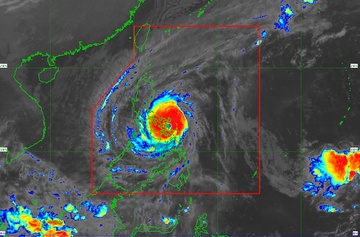CLARK FREEPORT — Typhoon Tisoy has left Luzon dams, including crucial ones supplying potable water for Metro Manila and irrigation to thousands of ricelands in Central Luzon, still below their normal level.
In a report, the Philippine Atmospheric, Geophysical and Astronomical Services Administration (Pagasa) noted that as of Dec. 5, Angat Dam reservoir water level (RWL) was at 1`94.52 meters, still below its normal high water level (NHWL) of 212 meters.
Tisoy, initially forecast to be the strongest typhoon to hit the country this year, also failed to satisfactorily fill up seven other dams in Luzon.
These dams provide both potable water for large populations as well as irrigation to thousands of hectares of ricelands.
The exception was Ipo Dam whose RWL was at 101.09 meters, a little above its NHWL of 101 meters.
La Mesa Dam’s NWL was noted at 77.61 meters, below its 80.15 NHWL, while Ambuklao’s 742.84 meters of RWL also was lower than its 752 NHWL.
At Binga Dam, the RWL was at 569.88 meters, below its 575 meters of NHWL.
San Roque Dam’s RWL was at 278.25, also below its 280 NHWL.
At Pantabangan, Pagasa recorded 211.96 RWL, still short of its 221-meter NHWL, while Magat Dam’s 191.61 RWL was still under 193 NHWL.
Metro Manila derives its water supply from the Angat, Ipo, and La Mesa dams. The water from these dams are then processed by the La Mesa and Balara treatment plants, which converts it from a raw state to clean and potable water.
The water from the Angat Dam, the major supply source for the metropolis, is funneled directly to Ipo Dam. It then flows a distance of 6.4 kilometers to Bicti, after which it passes through five aqueducts – each about 16 kilometers long – to the La Mesa Dam and the La Mesa Portal. From the La Mesa Portal, 60 percent of the fl ow goes to the nearby La Mesa Treatment Plant, out of which another 40 percent again travels a distance of 6.8 kilometers to the Balara Treatment Plant. The La Mesa Water Treatment Plant, with very minimal electromechanical equipment, relies mostly on water’s hydraulic properties to backwash its filter and gravity to convey raw water from the source into the plant and out into the distribution system.
It can only process 2,400 MLD (million liters per day) of raw water, while the Balara treatment plant, which has a full production capacity of 1,600 MLD, can supply more than 6 million people throughout the metropolis.
When both Balara and La Mesa treatment plants are in operation, the total processing capacity will be 4,000 MLD. The La Mesa water treatment plant serves the western half of Metro Manila, while the existing Balara water treatment plant supplies the eastern half.





